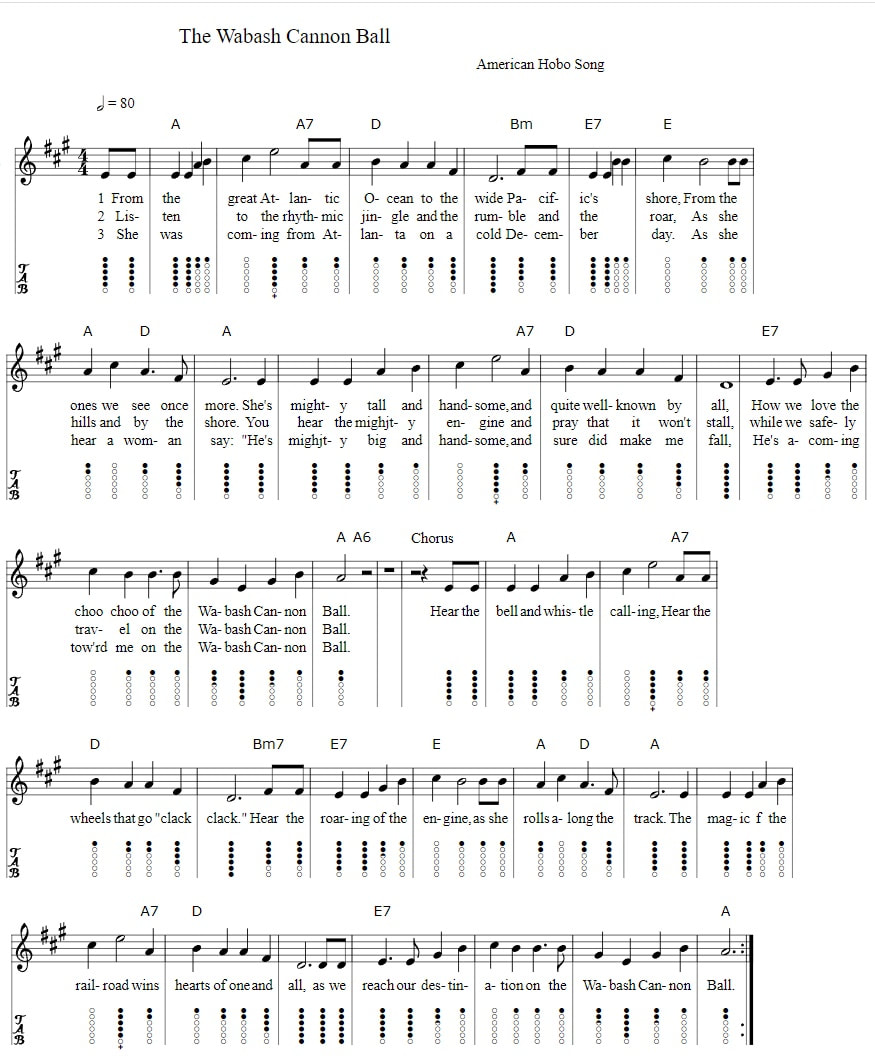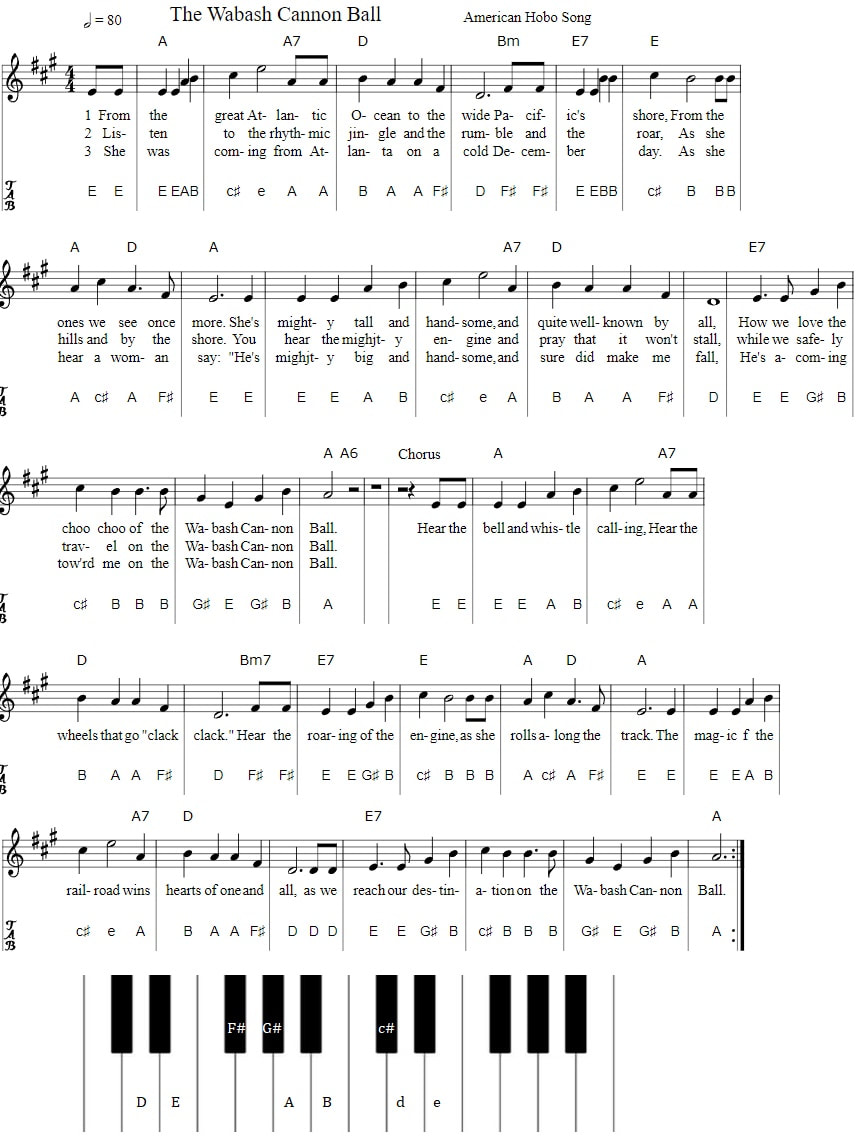The Wabash Cannonball Tin Whistle Tab
The Wabash Cannonball Tin Whistle Tab and piano keyboard letter notes for beginners, which are suitable for the flute and recorder .
The Wabash Cannonball is a popular American folk song that has been passed down through generations and has become an iconic piece of American culture. The song's origins can be traced back to the late 19th century, and it has since evolved and been recorded by countless musicians, making it one of the most recognizable and enduring American folk songs.
The Wabash Cannonball is often considered a train song, with its lyrics depicting a journey on a train known as the 'Wabash Cannonball'. However, the song's true meaning and origins are steeped in a rich history that goes beyond just a simple train ride.
The origins of the Wabash Cannonball can be traced back to the early 1880s, when it was first sung by a group of blackface minstrels known as the Carter Family. The song was originally titled 'The Great Rock Island Route' and was written by J. A. Roff, a black composer from Missouri. The Carter Family changed the name to Wabash Cannonball, and it quickly became a popular song among minstrel groups and traveling performers.
The song's popularity continued to grow in the early 20th century, and it was recorded by various artists such as the Carter Family, Roy Acuff, and Bing Crosby. However, it was not until the 1930s that the Wabash Cannonball gained widespread recognition and became a staple in American folk music.
One of the key reasons for the song's popularity was its relatability to the American people. At a time when the country was going through economic turmoil, the Wabash Cannonball represented a sense of adventure, freedom, and escape from the harsh realities of everyday life. The train symbolized the journey towards a better life and the hope of a brighter future.
Moreover, the Wabash Cannonball's popularity was also aided by the rise of radio and the recording industry. With the increasing accessibility of music through these mediums, the song reached a wider audience and became a hit not just in America but also in other parts of the world.
In addition to its popularity, the Wabash Cannonball also holds historical significance. The song's lyrics mention various cities and landmarks along the Wabash Railroad, which was a major transportation route in the late 19th and early 20th century. This railroad played a crucial role in the development and expansion of the American Midwest, connecting cities and towns and facilitating the transportation of goods and people.
Furthermore, the Wabash Cannonball has been a source of inspiration for other artists and has been recorded in various genres, including country, bluegrass, and rock. It has been covered by renowned artists such as Johnny Cash, Bob Dylan, and Neil Young, cementing its place in American music history.
The enduring popularity of the Wabash Cannonball can also be attributed to its adaptability and evolution over the years. The song's lyrics and melody have been modified and reinterpreted by different musicians, making it a versatile and ever-evolving piece of music.
Despite its widespread popularity, the true origins of the Wabash Cannonball remain somewhat of a mystery. Some claim that the song was inspired by an actual train named 'The Wabash Cannonball', while others believe it was a figment of the imagination of the song's creators. Whatever its true origins may be, there is no denying the impact that the Wabash Cannonball has had on American culture and music.
In conclusion, the Wabash Cannonball is more than just a train song. It is a symbol of American history, a source of inspiration, and a testament to the enduring power of folk music. Its widespread popularity and enduring legacy make it a beloved and timeless piece of American culture that will continue to be sung and enjoyed for generations to come.
The Wabash Cannonball is often considered a train song, with its lyrics depicting a journey on a train known as the 'Wabash Cannonball'. However, the song's true meaning and origins are steeped in a rich history that goes beyond just a simple train ride.
The origins of the Wabash Cannonball can be traced back to the early 1880s, when it was first sung by a group of blackface minstrels known as the Carter Family. The song was originally titled 'The Great Rock Island Route' and was written by J. A. Roff, a black composer from Missouri. The Carter Family changed the name to Wabash Cannonball, and it quickly became a popular song among minstrel groups and traveling performers.
The song's popularity continued to grow in the early 20th century, and it was recorded by various artists such as the Carter Family, Roy Acuff, and Bing Crosby. However, it was not until the 1930s that the Wabash Cannonball gained widespread recognition and became a staple in American folk music.
One of the key reasons for the song's popularity was its relatability to the American people. At a time when the country was going through economic turmoil, the Wabash Cannonball represented a sense of adventure, freedom, and escape from the harsh realities of everyday life. The train symbolized the journey towards a better life and the hope of a brighter future.
Moreover, the Wabash Cannonball's popularity was also aided by the rise of radio and the recording industry. With the increasing accessibility of music through these mediums, the song reached a wider audience and became a hit not just in America but also in other parts of the world.
In addition to its popularity, the Wabash Cannonball also holds historical significance. The song's lyrics mention various cities and landmarks along the Wabash Railroad, which was a major transportation route in the late 19th and early 20th century. This railroad played a crucial role in the development and expansion of the American Midwest, connecting cities and towns and facilitating the transportation of goods and people.
Furthermore, the Wabash Cannonball has been a source of inspiration for other artists and has been recorded in various genres, including country, bluegrass, and rock. It has been covered by renowned artists such as Johnny Cash, Bob Dylan, and Neil Young, cementing its place in American music history.
The enduring popularity of the Wabash Cannonball can also be attributed to its adaptability and evolution over the years. The song's lyrics and melody have been modified and reinterpreted by different musicians, making it a versatile and ever-evolving piece of music.
Despite its widespread popularity, the true origins of the Wabash Cannonball remain somewhat of a mystery. Some claim that the song was inspired by an actual train named 'The Wabash Cannonball', while others believe it was a figment of the imagination of the song's creators. Whatever its true origins may be, there is no denying the impact that the Wabash Cannonball has had on American culture and music.
In conclusion, the Wabash Cannonball is more than just a train song. It is a symbol of American history, a source of inspiration, and a testament to the enduring power of folk music. Its widespread popularity and enduring legacy make it a beloved and timeless piece of American culture that will continue to be sung and enjoyed for generations to come.


